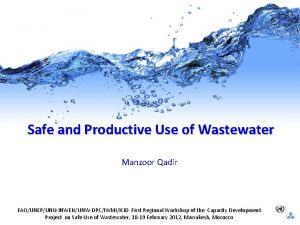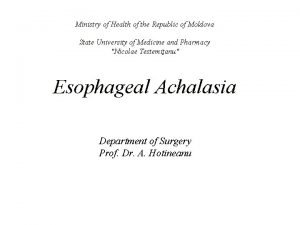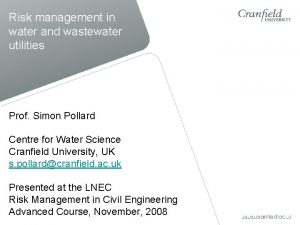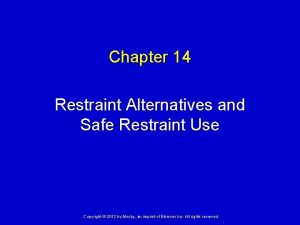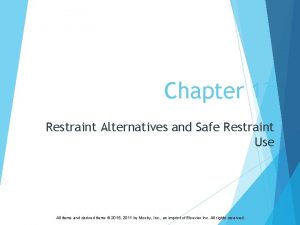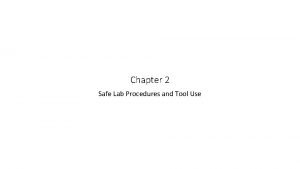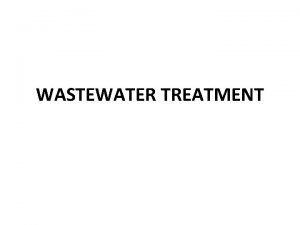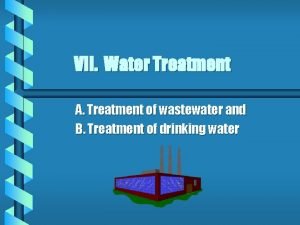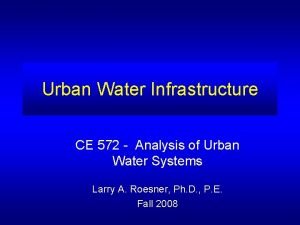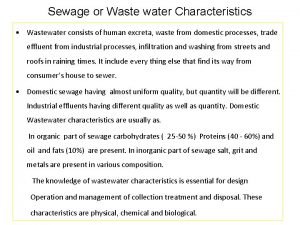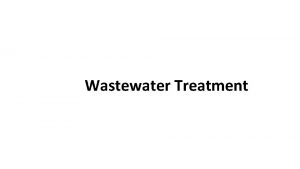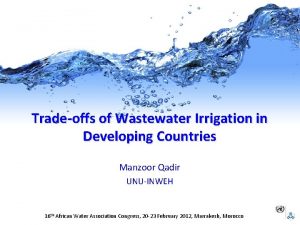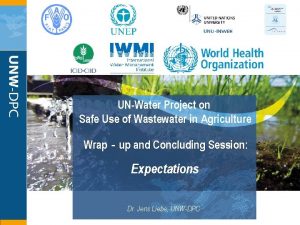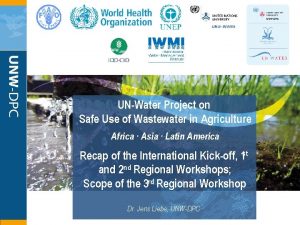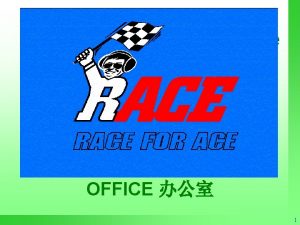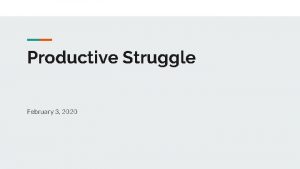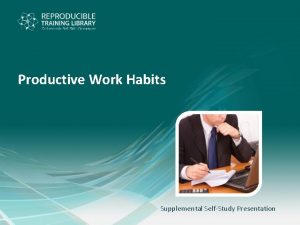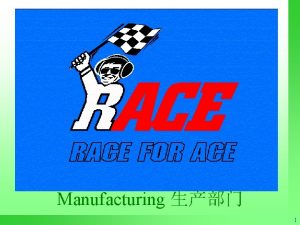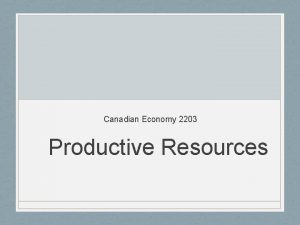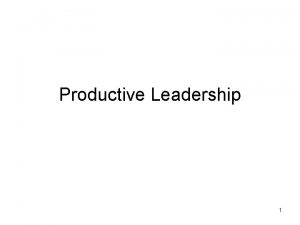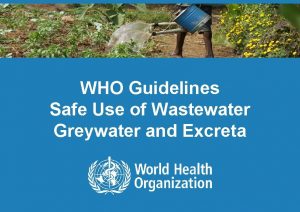Safe and Productive Use of Wastewater Manzoor Qadir



















- Slides: 19

Safe and Productive Use of Wastewater Manzoor Qadir FAO/UNEP/UNU-INWEH/UNW-DPC/IWMI/ICID First Regional Workshop of the Capacity Development Project on Safe Use of Wastewater, 18 -19 February 2012, Marrakesh, Morocco

Wastewater Use in AAAA § Agriculture § Agroforestry § Aquaculture § Aquifer recharge

Key Issues and Challenges § Most developing countries and countries in transition have yet to reach fullcapacity wastewater treatment § Policies and regulatory measures that encourage wastewater treatment and reuse of treated wastewater are lacking § Wastewater is available to the farmers in untreated, inadequately treated, or diluted forms

Incentives for the Farmers § Reliable availability of a water resource amid water scarcity § Savings on fertilizer use (wastewater contains nutrients) § Less pumping cost if alternate water source is groundwater § Additional benefits: high-value crops; increased cropping intensities

Categories of Wastewater Use § Direct use of untreated wastewater occurs from a sewage outlet when it is directly disposed of on a land for irrigation § Direct use of treated wastewater occurs when wastewater has undergone treatment before it is used for irrigation or recycling purposes

Categories of Wastewater Use § Indirect use of untreated wastewater occurs when water from a river receiving untreated wastewater is abstracted by farmers downstream for agriculture. This happens when cities do not have comprehensive sewage collection network and wastewater is discharged into rivers.

Categories of Wastewater Use § Indirect use of inadequately treated wastewater occurs when water from a river receiving such wastewater is abstracted by farmers downstream for agriculture. This happens when cities have sewage collection network, but wastewater treatment is inadequate.

Categories of Wastewater Use § Planned use of wastewater refers to the conscious and controlled use of wastewater either in raw (direct) or diluted (indirect) forms. § Unplanned use of wastewater refers to unregulated use of wastewater either in raw (direct) or diluted (indirect) forms; common in developing countries

Wastewater Program at UNU-INWEH § Recent initiative in partnership with: § ICARDA – Wastewater and greywater reuse in dry areas, environmental impact assessment of wastewater reuse § IWMI – Regional wastewater assessment; resource recovery from wastewater and greywater § ACWUA – Wastewater and greywater reuse in the Arab region § FAO/UNEP/UNW-DPC – Capacity Development Project on safe use of wastewater in agriculture

Some Examples. . . .

Economics of Wastewater Use § Based on crop cultivation, fertilizer use, farm labor, and irrigation costs § Some costs such as environmental and health costs were not included § Benefit: cost ratio was almost double from wastewater-irrigated area

Use of Wastewater for Agroforestry § Almaty, Kazakhstan § Treated wastewater stored in Sorbulak lake § Four agroforestry species Silver-leaf poplar (Populus alba L. ) Ash (Fraxinus excelsior L. ) White mulberry (Morus alba L. ) Dog rose (Rosa canina L. )

Use of Wastewater for Agroforestry § 5 -year irrigation with wastewater didn’t increase metal ion concentration in soil above the respective permissible levels § Increase in nutrient availability status of the soil because of nutrients added with wastewater irrigation

Use of Greywater for Olive Irrigation § Amman, Jordan § Part of domestic effluent consisting of kitchen and bathroom wastewater (50 -80% of residential wastewater) § Separated from domestic wastewater, treated, and reused § Greywater use for home farming to irrigate high-value olives contribute to income generation at household level in dry areas

Greywater Treatment System To the irrigation system Green removal panel Screen Filter Stone Manholesteel cover Vales

Environmental Impact Assessment of Irrigation with Untreated or Inadequately Treated Wastewater

Nitrogen in Groundwater

Heavy Metals in Groundwater

Conclusions § Urban wastewater and greywater in water scarce countries is a valuable resource that needs: § Implementation of treatment and regulated use of wastewater § Monitoring systems and implementation of WHO guidelines § Skilled human resources and institutional capacity § Pertinent and flexible policy frameworks § Regulated use of treated wastewater offers great promise for environment and health protection as well as livelihoods resilience
 Dr manzoor qadir
Dr manzoor qadir Abdul qadir hasan baraja
Abdul qadir hasan baraja Sheikh abdul qadir jilani family tree
Sheikh abdul qadir jilani family tree Dr haris manzoor qadri
Dr haris manzoor qadri Types of dysphagia
Types of dysphagia Presbydysphagia
Presbydysphagia Safe feed safe food
Safe feed safe food Safe people safe places
Safe people safe places Risk management for water and wastewater utilities
Risk management for water and wastewater utilities Restraint alternatives and safe restraint use
Restraint alternatives and safe restraint use Restraint alternatives and safe restraint use
Restraint alternatives and safe restraint use Safe lab procedures and tool use
Safe lab procedures and tool use Safe lab procedures and tool use
Safe lab procedures and tool use Wastewater treatment purpose
Wastewater treatment purpose Aquaculture wastewater treatment
Aquaculture wastewater treatment Wastewater treatment process primary secondary tertiary
Wastewater treatment process primary secondary tertiary Wastewater distribution system
Wastewater distribution system Typical composition of untreated domestic wastewater
Typical composition of untreated domestic wastewater Physical characteristics of wastewater
Physical characteristics of wastewater Optimize wastewater lagoon
Optimize wastewater lagoon
